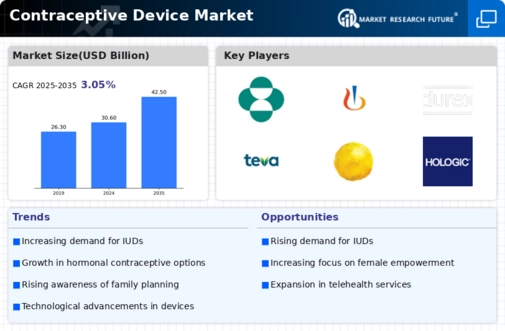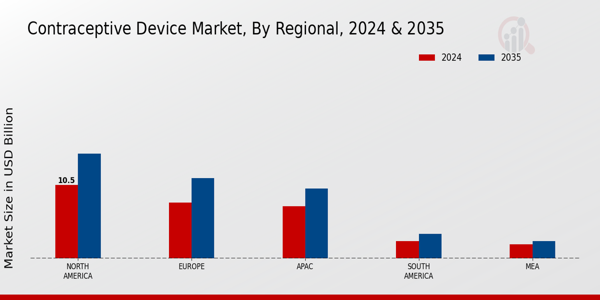Diverse Product Offerings
The Global Contraceptive Device Market Industry benefits from a diverse range of product offerings that cater to varying consumer preferences and needs. This diversity includes hormonal contraceptives, barrier methods, and permanent solutions, allowing consumers to choose options that align with their lifestyles. For instance, the availability of non-hormonal IUDs appeals to those seeking alternatives to hormonal methods. Additionally, the introduction of eco-friendly contraceptive options is gaining traction among environmentally conscious consumers. This variety not only enhances consumer choice but also drives market growth as manufacturers innovate to meet the evolving demands of the population.
Market Growth Projections
The Global Contraceptive Device Market Industry is poised for substantial growth, with projections indicating a market value of 30.6 USD Billion in 2024 and an anticipated increase to 42.5 USD Billion by 2035. This growth trajectory suggests a robust compound annual growth rate (CAGR) of 3.04% from 2025 to 2035. Such projections reflect the increasing recognition of the importance of contraceptive devices in reproductive health and family planning. As more individuals seek effective solutions to manage their reproductive health, the market is likely to expand, driven by innovations, government initiatives, and evolving consumer preferences.
Government Initiatives and Policies
Government initiatives and policies significantly influence the Global Contraceptive Device Market Industry. Many countries are implementing policies that promote access to contraceptive devices as part of broader public health strategies. For instance, subsidized contraceptive programs in various nations aim to reduce costs for consumers, thereby increasing accessibility. Additionally, policies that support reproductive health education in schools contribute to informed decision-making among young individuals. Such initiatives are likely to foster a more favorable environment for contraceptive use, ultimately driving market growth and ensuring that the industry adapts to the evolving needs of the population.
Rising Demand for Family Planning Services
The Global Contraceptive Device Market Industry is witnessing a surge in demand for family planning services, driven by changing societal norms and economic factors. As more individuals prioritize career development and personal goals, the need for effective contraceptive solutions becomes increasingly apparent. This trend is particularly evident in urban areas, where access to family planning services is more readily available. The growing acceptance of family planning as a means to achieve economic stability and improved quality of life is likely to propel market growth. The industry is expected to expand at a CAGR of 3.04% from 2025 to 2035, reflecting this rising demand.
Increasing Awareness of Reproductive Health
The Global Contraceptive Device Market Industry experiences growth due to heightened awareness regarding reproductive health. Educational campaigns led by governments and NGOs emphasize the importance of family planning and contraceptive use. This awareness is crucial in regions with high birth rates, where access to contraceptive devices can significantly reduce unintended pregnancies. For instance, in many developing countries, initiatives have been launched to educate women about their reproductive rights and available contraceptive options. As a result, the market is projected to reach 30.6 USD Billion in 2024, reflecting a growing recognition of the need for effective contraceptive solutions.
Technological Advancements in Contraceptive Devices
Technological innovations play a pivotal role in shaping the Global Contraceptive Device Market Industry. The introduction of advanced contraceptive methods, such as long-acting reversible contraceptives (LARCs) and digital health solutions, enhances user experience and effectiveness. For example, the development of intrauterine devices (IUDs) with improved materials and designs has increased their acceptance among users. Furthermore, the integration of mobile applications for tracking menstrual cycles and contraceptive use is gaining traction. These advancements not only improve user satisfaction but also contribute to the projected market growth, with an anticipated value of 42.5 USD Billion by 2035.















